The policy for a Java runtime, specifying which
permissions
are available for code from various sources, is represented
by a Policy object. The default Policy implementation obtains its
information from static ASCII policy configuration files.
A policy file can be composed via a simple text editor, or via the
graphical Policy Tool utility described in this document.
Using the Policy Tool saves typing and eliminates the need
for you to know the required syntax of policy files, thus
reducing errors.
The Permissions and Policy Files Overview
section of this document describes what permissions are,
and provides information about policy file contents and default
policy files. It also supplies links to more detailed discussions of
these topics.
The Policy Tool Usage
section describes how to use the
Policy Tool to create and modify policy files.
The Examples
section provides detailed examples of the use of Policy Tool.
The See Also
section provides links to related documentation.
This section briefly describes what permissions are,
and provides information about policy file contents and default
policy files.
A permission represents access to a system resource.
In order for a resource access to be allowed for an applet
(or an application running with a security manager),
the corresponding permission must be explicitly granted to
the code attempting the access.
A permission typically has a name (often referred to as a
"target name") and, in some cases, a comma-separated list of
one or more actions. For example, to
create a permission to read the file named "abc" in the
D:\tmp\ directory, you'd create a File Permission (technically, a
java.io.FilePermission permission) with target name
"D:\tmp\abc" and action string "read".
In the default Policy implementation, code trying to
read the file must be granted the specified permission by a "policy entry"
(sometimes referred to as a "grant entry") in a policy
configuration file. The Policy Tool can be used to create such
an entry in such a file.
The Permissions in JDK 1.2
document contains tables that describe the built-in
JDK 1.2 permission types and that discuss the risks of granting each
permission. It also contains tables showing the JDK 1.2 methods that
require permissions to be in effect in order to be successful,
and for each lists the required permission.
There is by default a single system-wide policy file, and an optional
user policy file.
The system policy file is by default located at
java.home\lib\security\java.policy
Here, java.home is
the runtime environment's directory (the jre directory in
the SDK or the top-level directory of the Java 2 Runtime Environment).
The user policy file is by default located at
user.home\.java.policy
Here, user.home indicates the
user's home directory.
When the Policy is initialized, the system policy is loaded in first, and
then the user policy is added to it. If neither policy is present, a built-in
policy is used. This built-in policy is the same as the original sandbox policy.
Policy file locations are specified in the security properties file, which is
located at
java.home\lib\security\java.security
The policy file locations are specified as the values of properties whose names
are of the form
policy.url.n
Here, n indicates a number. You specify each such property
value in a line of the following form:
policy.url.n=URL
Here, URL is a URL specification.
For example, the default policy files, sometimes referred to as
the "system" and "user" policy files, respectively,
are defined in the security properties file as
policy.url.1=file:${java.home}/lib/security/java.policy
policy.url.2=file:${user.home}/.java.policy
Note: when a string like
${some.property}
appears in a policy file, or in the security properties file, it will be expanded
to the value of the specified system property. For example,
${java.home}
indicates the value of the java.home property specifying the runtime environment's directory (the jre directory in
the SDK or the top-level directory of the Java 2 Runtime Environment).
Whether or not property expansion is allowed is controlled by the value
of the "policy.expandProperties" property in the security properties
file. If the value of this property is true (the default), expansion is
allowed.
You can actually specify a number of URLs in the security properties
file (including ones of the form "http://"),
and all the designated policy files will get loaded. You can also comment out or
change the second one to disable reading the default user policy file.
The algorithm starts at policy.url.1, and keeps incrementing until it does not
find a URL. Thus if you have policy.url.1 and policy.url.3, policy.url.3 will
never be read.
It is also possible to specify an additional or a different policy file when
invoking execution of an application. This can be done via the
"-Djava.security.policy" command-line argument, which sets the value of
the java.security.policy property. For example, if you
type the following, where pURL is a URL indicating
the location of a policy file, then the
specified policy file will be loaded in addition to all the policy files
that are specified in the security properties file.
java -Djava.security.manager -Djava.security.policy=pURL SomeApp
(The
"-Djava.security.manager" argument ensures that the default security
manager is installed, and thus the application is subject to policy checks.
It is not required if the application SomeApp installs a security manager.)
If you instead type the following, using a double equals, then
just the specified policy file will be used; all others will be ignored.
java -Djava.security.manager -Djava.security.policy==pURL SomeApp
If you want to pass a policy file to the appletviewer, again use a
"-Djava.security.policy" argument as follows:
appletviewer -J-Djava.security.policy=pURL myApplet
Please note: The "-Djava.security.policy" policy file value will be ignored
(for both java and appletviewer commands) if the "policy.allowSystemProperty"
property in the security properties file is set to false. The default is true.
A policy configuration file (policy file, for short) indicates
what permissions are allowed for code from specified code sources.
A policy configuration file contains a list of entries.
It may contain a single "keystore" entry, and contains zero or more "policy"
(or "grant") entries.
A keystore is a database of private keys and their associated digital
certificates such as X.509 certificate chains authenticating the
corresponding public keys. The keytool
utility is used to create and administer keystores. The keystore
specified in a policy configuration
file is used to look up the public keys of the signers (if any) specified in the
grant entries of the file. Public keys are used to verify the digital
signatures used to sign the code.
A keystore entry must appear in a policy
configuration file if any policy entries specify signer aliases.
At this time, there can be only one keystore entry in the policy file.
The keystore entry specifies the URL location of the keystore and
optionally the keystore type.
The URL is relative to the policy file location. Thus if the policy
file is specified in the security properties file as:
policy.url.1=http://foo.bar.com/blah/some.policy
and that policy file has a keystore entry with value ".keystore"
then the keystore will be loaded from:
http://foo.bar.com/blah/.keystore
The URL can also be absolute.
A keystore type defines the storage and data format of the keystore
information, and the algorithms used to
protect private keys in the keystore and the integrity of the keystore
itself. If you don't specify a type, it is assumed to be that
specified by the "keystore.type" property value in the security
properties file. The value is initially "JKS", specifying
a proprietary keystore type
supported by Sun Microsystems.
Code being executed is always considered to come from a particular
"code source". The code source may include not only the CodeBase
location (URL) where the applet (or application) originated from,
but also a reference to one or more (symbolic) alias
names from a keystore specifying the keystore entries containing
the public key(s) corresponding to the private key(s) used to sign
the code.
Each policy entry in the policy file contains the following:
- an optional CodeBase entry specifying the URL location where the code
originates from,
- an optional SignedBy entry specifying the alias name from the
keystore used to reference the signer whose private key was used to
sign the code, and
- one or more permission entries specifying which permissions
are granted to code from the specified CodeBase and signed
by the specified SignedBy alias.
To start Policy Tool, simply type the following
at the command line.
policytool
This brings up the "Policy Tool" window.
Whenever Policy Tool
is started, it tries to
fill in this window with policy information from what is sometimes referred to
as the "user policy file".
The user policy file is by default a file named .java.policy in your
home directory.
If Policy Tool cannot find the user policy file, it reports
the situation and displays a blank "Policy Tool" window
(that is, a window with headings and buttons but no data in it):
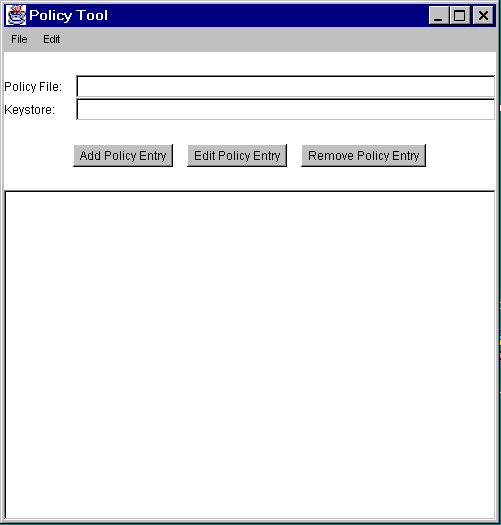
You can then proceed to either
open whatever policy file you want to work on
or create a new policy file, by
adding policy entries, optionally
specifying a keystore, and
saving the file).
The first time you run the Policy Tool, there will not be a
user policy file (unless you created one manually).
To create a new policy file, start by simply selecting the New command
from the File menu. This will close the currently open policy
file (if any, after first prompting you to save it if needed) and bring
up a new policy tool window, that is, a window with headings
and buttons but no data in it.
Please Note: this is not necessary the first time
you run the Policy Tool. Since the tool tries to open the user policy
file and one doesn't exist yet (unless it was created manually),
the tool will bring up a window without any data in it.
Once you have a new policy tool window, you can then
create the policy entries,
and specify the keystore (if any of
the policy entries specify a keystore alias).
At any point, you can save the policy file.
To work on a different policy file than the one currently being
worked on (if any), use the Open command in the
File menu.
This will close the currently open policy
file (if any, after first prompting you to save it if needed) and
will present you with an Open dialog, which you can use
to navigate the directory structure until you get to the
directory containing the policy file you want to work on.
Select that file, then select the Open button.
The "Policy Tool" window will then be filled in with information
from the policy file, including the policy file name,
the keystore URL (if any), and the CodeBase and SignedBy parts
of each policy entry in the policy file.
To specify the keystore containing the key information for
the aliases specified in the SignedBy parts of policy entries,
select the Change Keystore command in the
Edit menu.
This brings up a dialog box in which you specify the new
keystore URL and optionally the keystore type.
As an example, to specify the keystore named "mykeystore" in the
Tests directory on the D: drive, type the following
file: URL into the text box labeled "New KeyStore URL".
file:/D:/Tests/mykeystore
To also specify that the keystore type is "JKS" (the proprietary
keystore type supported by Sun Microsystems), type
the following into the text box labeled "New KeyStore Type".
JKS
Note: the "New KeyStore URL" value is a URL and thus should always utilize
slashes (never backslashes) as the directory separator, even when
the keystore is actually on a Windows system.
When you are done specifying the keystore URL and
type (if any), select OK
(or you can select Cancel to cancel the operation).
If you didn't cancel, the text box labeled "Keystore:" is now
filled in with the keystore URL and type.
To add a new policy entry, select the Add Policy Entry button
in the main "Policy Tool" window.
This brings up a "Policy Entry" dialog box:
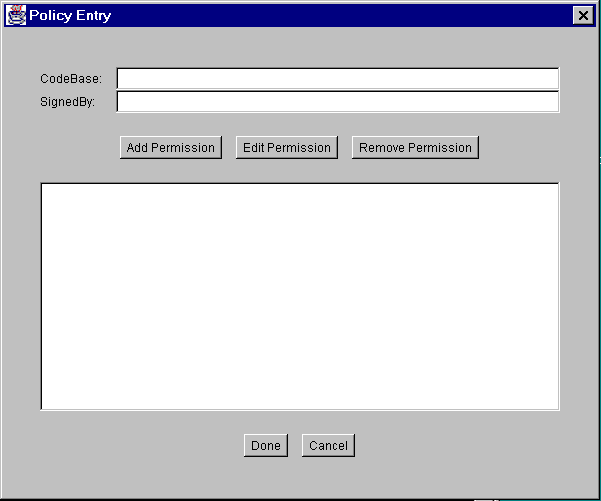
Using this dialog box, you specify
The SignedBy value is a string alias that is mapped (using the
keystore) to a set of public keys that are associated with the signers.
These keys are used to verify that classes from the specified code source
are really signed by these signers.
The SignedBy value can be a comma-separated string containing
names of multiple signers, an example of which is "Adam,Eve,Charles", which
means "signed by Adam and Eve and Charles" (i.e., the relationship is AND,
not OR).
The SignedBy value is optional in that, if it is omitted,
it signifies "any signer," or in other words, it doesn't matter whether
the code is signed or not.
Similarly, if there is no CodeBase entry, then it
signifies "any code"; it doesn't matter where
the code originates from.
Thus, if there is no CodeBase entry, then all code signed
by the specified alias(es) will be granted the specified permissions.
If there is no SignedBy entry, then all code from
the specified CodeBase will be granted the specified permissions,
regardless of whether the code is signed or not, and by whom.
If there is no CodeBase entry, and also no
SignedBy entry, then all code will be granted the specified permissions.
Note: The exact meaning of a CodeBase value depends on the
characters at the end. A CodeBase with a trailing "/"
matches all class files (not JAR files) in the specified directory.
A CodeBase with a trailing "/*" matches
all files (both class and JAR files) contained in that directory.
A CodeBase with a trailing "/-" matches
all files (both class and JAR files) in the directory and
recursively all files in subdirectories contained in that directory.
To add a new permission, select the Add Permission button
in the "Policy Entry" dialog box.
This brings up the "Permissions" dialog box:
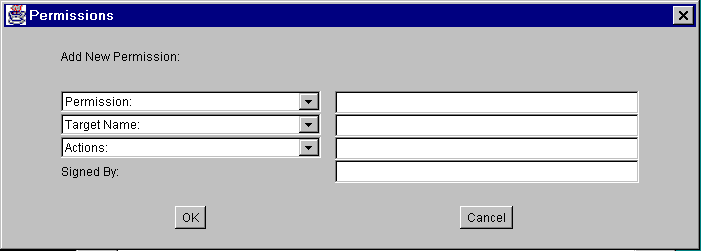
To add the permission:
- Type or select a permission type.
The drop-down list
labeled "Permission:" contains a list of built-in permission
types. If you want such a type, select it from the list, and the
complete permission type name appears in the text box to the
right of the drop-down list.
If you instead want to specify a permission type defined by you
or others, type the permission type into the text box.
- Type or select a permission target name.
If you selected a built-in permission from the "Permission:"
drop-down list, and permissions of that type have specific
target name values, then the drop-down list
labeled "Target Name:" contains a list of those values, from
which you can choose.
In some cases, where the target name
possibilities are infinite but there are some built-in target name
specifications that have special meaning, such target names will
appear in the drop-down list. For example, the special target name
of "<<All Files>>" will appear in the list for File Permissions.
To specify a target name not available in the drop-down list,
type the target name directly into the text box to the
right of the "Target Name:" drop-down list. For example, to specify
the file named data in the JavaSoft\ptTest\
directory on the D: drive, type
D:\JavaSoft\ptTest\data
- Type or select one or more actions, if actions are relevant.
Some permissions just have a target name, but no actions. For such
permissions, leave the text box to the right of the "Actions:" drop-down list
blank. (It will automatically be darkened and unavailable for this type of built-in
permission.)
For permissions requiring action specifications, type the comma-separated
list of actions into the text box, or select them from the drop-down list.
For example, to specify both read and write access to a file specified for a
File Permission, first select read (or write,
order doesn't matter)
from the list. The word "read" appears in the text box. Then select
write, and the word "write" will be appended,
preceded by a comma and a space.
- Type a SignedBy alias into the text box to the right of the
"Signed By" label, if required.
The SignedBy value for a permission entry
is optional. If present, it indicates a signed permission. That is,
the permission class itself must be signed by the given alias(es) in
order for the permission to be granted.
When you are done specifying the permission information, select the
OK button (or Cancel to cancel). The new permission appears in a line
in the "Policy Entry" dialog.
You can then add additional permissions by following the same sequence
of steps. Or you can edit an existing permission
or remove a permission.
To edit an existing permission, select the line for that permission in the
"Policy Entry" dialog box, then select the Edit Permission button.
Alternatively, you can simply double-click the line for that permission.
This brings up the same type of "Permissions" dialog box as appears
when you are adding a new permission, except
in this case the dialog box
is filled in with the existing permission information. To change the
information, either make new selections from the drop-down lists or
replace the information in the text boxes.
When you are done, select the
OK button (or Cancel to cancel changes).
The "Policy Entry" dialog now shows the permission with any modifications
you made.
To remove an existing permission, select the line for that permission in the
"Policy Entry" dialog box, then select the Remove Permission button.
Once you are done adding a policy entry, select the Done button
in the "Policy Entry" dialog, or Cancel to cancel.
If you selected Done, the "Policy Tool" window now contains a line
representing the policy entry. The line just contains the CodeBase and SignedBy
information (if any). If neither was specified in the "Policy Entry"
dialog, just
CodeBase <ALL>
appears.
Note: a warning is displayed upon closing the policy entry if
it contains any SignedBy
aliases that don't yet exist in your keystore. Select OK and
make a note to create such
an alias, or edit the policy entry to fix
the alias if was wrong.
To edit an existing policy entry, select the line for that entry in the main
"Policy Tool" window, then select the Edit Policy Entry button.
Alternatively, you can simply double-click the line for that entry.
This brings up the same type of "Policy Entry" dialog box as appears
when you are adding a new policy entry, except
in this case the dialog box
is filled in with the existing policy entry information.
To change the information, simply retype it (for the CodeBase and
SignedBy values) or add,
remove , or
modify permissions.
When you are done, select the
Done button (or Cancel to cancel).
To delete a policy entry from the policy file, select
the line for that entry in the main "Policy Tool" window,
then select the Remove Policy Entry button.
The complete policy entry is displayed, and you can then
either select OK to remove the entry, or Cancel to
keep it.
To save changes to an existing policy file, simply select the
Save command in the File menu.
To save a new policy file you've been creating, or to copy
an existing policy file to a new policy file with a different name,
select the Save As command from the
File menu. This brings up the Save As dialog box.
Navigate the directory structure to get to the directory
in which you want to save the policy file. Type the desired
file name, then select the Save button. The policy file is
now saved, and its name and path are shown in the text box labeled
"Policy File:"
To exit Policy Tool, select the
Exit command from the File menu.
If Policy Tool ever reports that warnings have been
stored in the Warning Log, you can view the log by selecting
the View Warning Log command in the Edit menu.
For example, if you have a policy file with a Keystore URL
specifying a keystore that doesn't yet exist, you will get
such a warning at various times, e.g., when you open the file.
You can continue to work on the policy file even if warnings exist.
Note: On Windows systems, when you type a file name and path into
a Policy Tool dialog box (e.g., as a FilePermission target name),
you can use any of the following as the directory separator:
- a single backslash, as in
D:\Temp\data
- a double backslash, as in
D:\\Temp\\data
- a slash, as in
D:/Temp/data
Single backslashes are the "normal" Windows directory separators,
and slashes are also accepted.
However, policy files themselves cannot contain single
backslashes. When a policy file is read, the strings are processed by
a tokenizer, which allows "\" to be used as an escape string
(e.g., "\n" to indicate a new line)
and which thus requires two backslashes to indicate a single backslash.
If you use single backslashes as your separators, Policy Tool
automatically converts them to double backslashes (e.g., after you
select OK in the Permissions dialog box), for your convenience.
The user policy file is by default the file named .java.policy
in your "home directory," as determined by the
user.home system property value.
Given user name uName, the user.home
property value defaults to
C:\Winnt\Profiles\uName on multi-user Windows NT systems
C:\Windows\Profiles\uName on multi-user Windows 95 systems
C:\Windows on single-user Windows 95 systems
Thus, if the user name is "cathy", user.home defaults to
C:\Winnt\Profiles\cathy on multi-user Windows NT systems
C:\Windows\Profiles\cathy on multi-user Windows 95 systems
C:\Windows on single-user Windows 95 systems
The following examples show how to
Initially, there is no
user policy file (unless you created one manually). So to create the
user policy file, first simply start Policy Tool by typing
the following at the command line.
policytool
This brings up the "Policy Tool" window.
Whenever Policy Tool
is started, it tries to
fill in this window with policy information from what is sometimes referred to
as the "user policy file".
The user policy file is by default a file named .java.policy in your
home directory.
If Policy Tool cannot find the user policy file, it reports
the situation and displays a blank "Policy Tool" window
(that is, a window with headings and buttons but no data in it):

You can now create the user policy file by adding entries and saving
the file.
Suppose you want to grant all classes from the Tests\ directory on
the D: drive permission to read the file named mydata in the
D:\Temp\data\ directory.
To do so, first select the Add Policy Entry button
in the main "Policy Tool" window.
This brings up a "Policy Entry" dialog box:

Using this dialog box, type the file URL
file:/D:/Tests/
into the CodeBase text box. (Note, this is a URL and thus must always have
slashes, not backslashes.)
Leave the SignedBy text box blank, since you aren't requiring the code
to be signed.
To add the permission, select the Add Permission button.
This brings up the "Permissions" dialog box:

To add the permission:
- Select "File Permission" from the "Permission:" drop-down list. The
complete permission type name (java.io.FilePermission) now appears in the
text box to the right of the drop-down list.
- Type the following in the text box to the right of the list labeled
"Target Name:":
D:\Temp\data\mydata
- Specify read access by selecting "read" from the
"Actions:" drop-down list.
Now the "Permission" dialog box looks like the following:
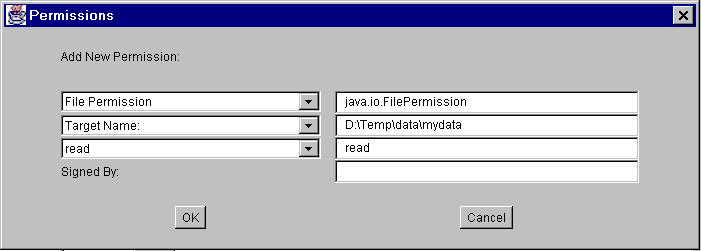
When you are done specifying the permission information, select the
OK button. The new permission appears in a line
in the "Policy Entry" dialog.
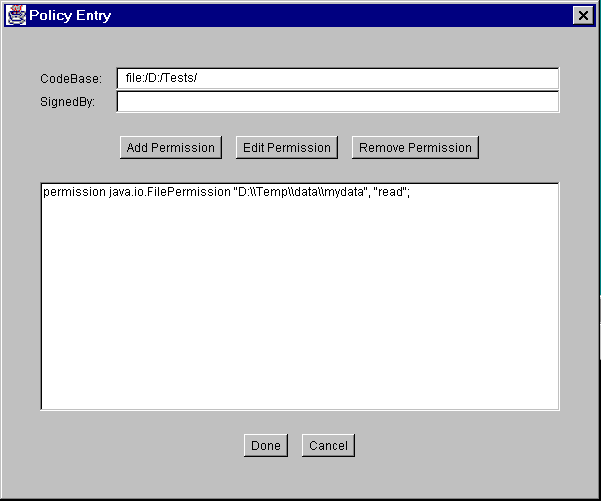
Note: Each backslash in the file path you typed has been replaced
with two backslashes, as described in
Note Regarding File Specifications.
You are now done specifying this policy entry, so select the Done
button. The "Policy Tool" window now contains a line
representing the policy entry. The line just contains the CodeBase value:
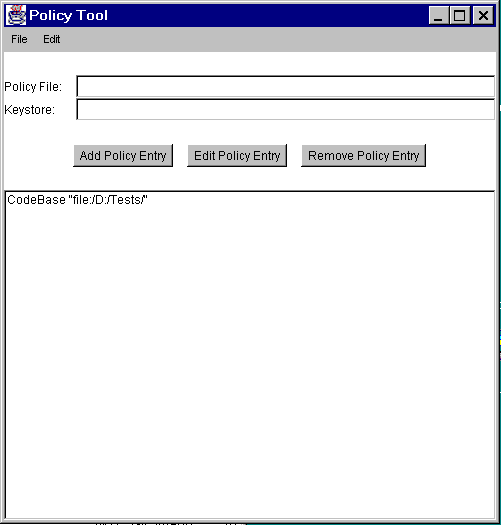
Suppose you also want to grant any code from the URL
"http://java.sun.com/" and
signed by the alias "duke"
read access to all files in the D:\tmp\ directory.
Suppose you also want to give such code permission
to initiate outgoing socket connections to any hosts.
You need to do two things:
- Specify the keystore containing the alias, and
- Create the policy entry
granting the permissions.
To specify the keystore containing the key information for
the aliases specified in any SignedBy parts of policy entries,
select the Change Keystore command in the
Edit menu of the main "Policy Tool" window.
This brings up a dialog box in which you specify the new
keystore URL and optionally the keystore type.
As an example, to specify the keystore named "mykeystore" in the
Tests directory on the D: drive, type the following
file: URL into the text box labeled "New KeyStore URL":
file:/D:/Tests/mykeystore
If the keystore type is the default type, as specified by the
"keystore.type" property value in the security properties
file, you don't need to type a "New KeyStore Type" value.
The default value of that property is "JKS"
(the proprietary keystore type supported by Sun Microsystems).
To specify the keystore type, type its value
into the text box labeled "New KeyStore Type."
For example, to indicate that the keystore type is "JKS"
type
JKS
The result is:
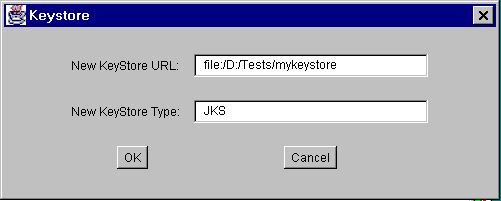
Note: the "New KeyStore URL" value is a URL and thus should always utilize
slashes (never backslashes) as the directory separator, even when
the keystore is actually on a Windows system.
When you are done specifying the keystore URL and type, select OK.
The text box labeled "Keystore:" is now
filled in with the URL and type.
Next, you need to specify the policy entry:
Select the Add Policy Entry button
in the main "Policy Tool" window.
This brings up the "Policy Entry" dialog box.
Type the following
into the the CodeBase text box:
http://java.sun.com/*
The "*" indicates that both class and JAR files in the specified directory
are to be considered to match this CodeBase.
Now, type the following alias into the SignedBy text box:
duke
To add the first permission, select the Add Permission button.
This brings up the "Permissions" dialog box. Do the following
- Select "File Permission" from the "Permission:" drop-down list. The
complete permission type name (java.io.FilePermission) now appears in the
text box to the right of the drop-down list.
- Type the following in the text box to the right of the list labeled
"Target Name:" to specify all files in the
D:\tmp\ directory:
D:\tmp\*
- Specify read access by selecting "read" from the
"Actions:" drop-down list.
Now the "Permissions" dialog box looks like the following:
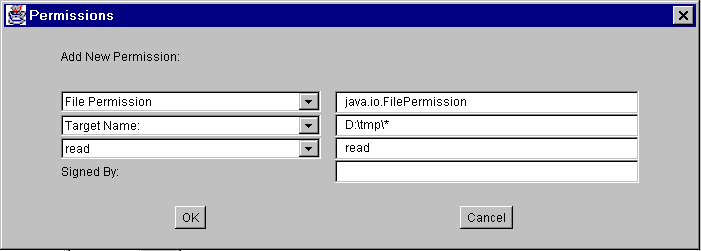
Select the
OK button. The new permission appears in a line
in the "Policy Entry" dialog.
Now you need to add the other permission. Select the Add Permission button.
In the "Permissions" dialog box, do the following
- Select "Socket Permission" from the "Permission:" drop-down list. The
complete permission type name (java.net.SocketPermission) now appears in the
text box to the right of the drop-down list.
- Type the following in the text box to the right of the list labeled
"Target Name:" to specify all hosts:
*
- Specify permission to make connections by selecting "connect" from the
"Actions:" drop-down list.
Now the "Permissions" dialog box looks like the following:
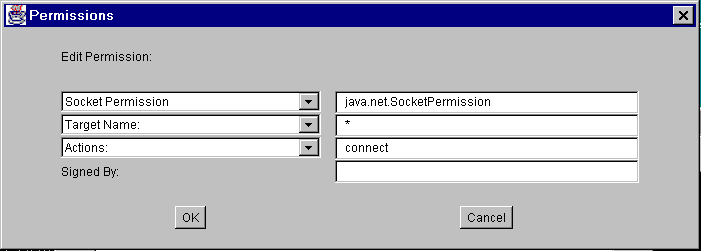
Select the
OK button. The new permission appears in a line
in the "Policy Entry" dialog.
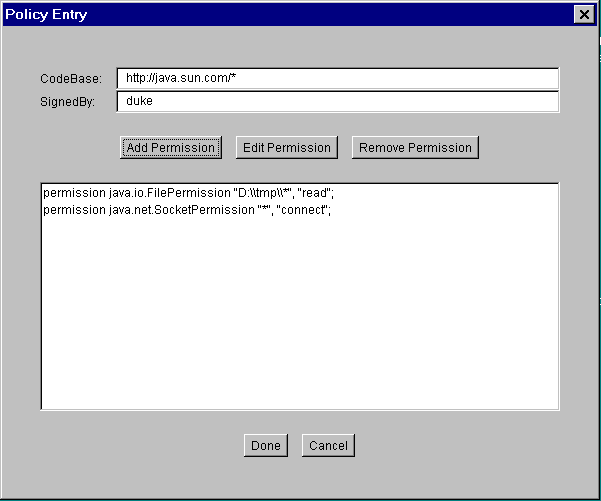
Note: Each backslash in the file path you typed has been replaced
with two backslashes, as described in
Note Regarding File Specifications.
You are now done specifying this policy entry, so select the Done
button in the "Policy Entry" dialog. The "Policy Tool" window now contains a line
representing the policy entry, showing the CodeBase and
SignedBy values.
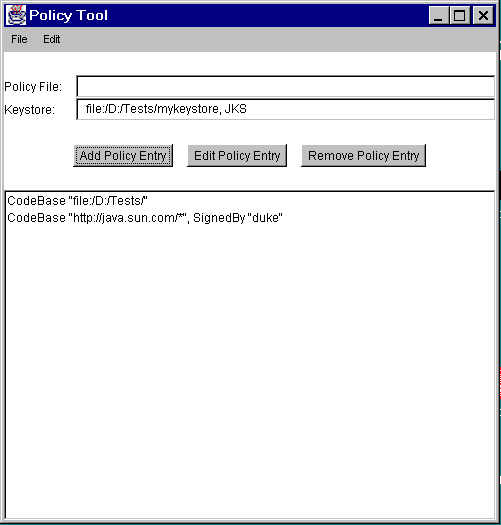
Let's assume you're working on a Win95 system and you
want to save the policy file you've been creating
with the default name (.java.policy) in the default location
(C:\Windows\).
To save the user policy file, select the Save As command from the
File menu. This brings up the Save As dialog box.
Navigate the directory structure to get to the Windows directory
on the C: drive. Type
.java.policy
(note the initial period) as
the file name, then select the Save button. The policy file is
now saved, and its name and path are shown in the text box labeled
"Policy File:"
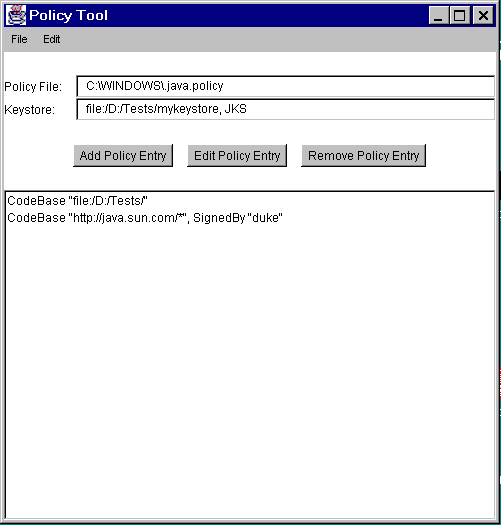
When you want to exit Policy Tool, do so by selecting the
Exit command from the File menu.











